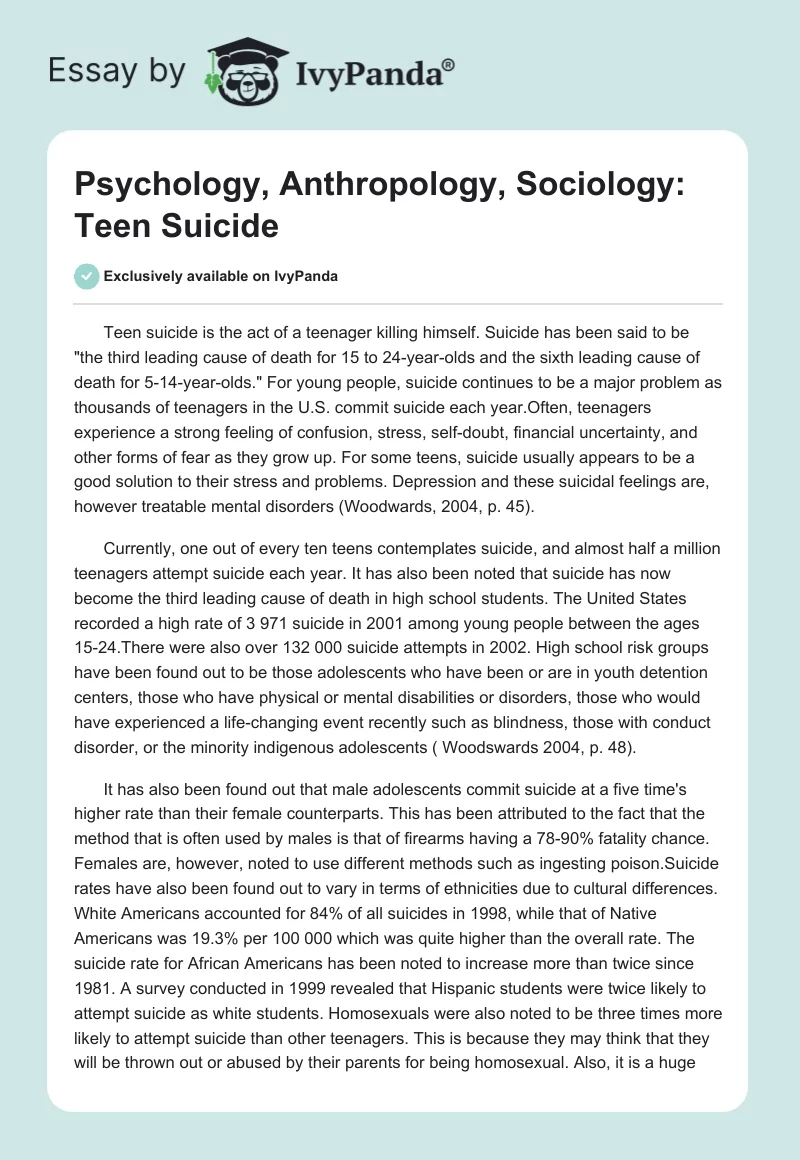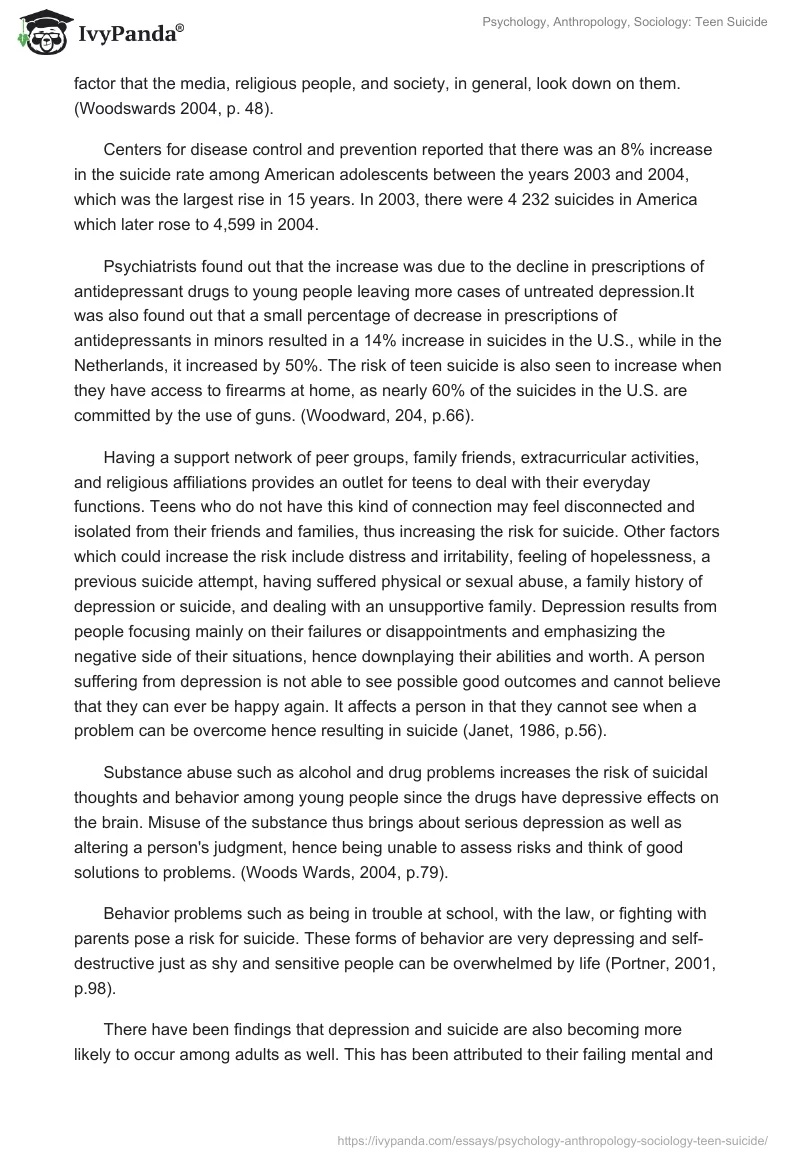Teen suicide is the act of a teenager killing himself. Suicide has been said to be “the third leading cause of death for 15 to 24-year-olds and the sixth leading cause of death for 5-14-year-olds.” For young people, suicide continues to be a major problem as thousands of teenagers in the U.S. commit suicide each year.Often, teenagers experience a strong feeling of confusion, stress, self-doubt, financial uncertainty, and other forms of fear as they grow up. For some teens, suicide usually appears to be a good solution to their stress and problems. Depression and these suicidal feelings are, however treatable mental disorders (Woodwards, 2004, p. 45).
Currently, one out of every ten teens contemplates suicide, and almost half a million teenagers attempt suicide each year. It has also been noted that suicide has now become the third leading cause of death in high school students. The United States recorded a high rate of 3 971 suicide in 2001 among young people between the ages 15-24.There were also over 132 000 suicide attempts in 2002. High school risk groups have been found out to be those adolescents who have been or are in youth detention centers, those who have physical or mental disabilities or disorders, those who would have experienced a life-changing event recently such as blindness, those with conduct disorder, or the minority indigenous adolescents ( Woodswards 2004, p. 48).
It has also been found out that male adolescents commit suicide at a five time’s higher rate than their female counterparts. This has been attributed to the fact that the method that is often used by males is that of firearms having a 78-90% fatality chance. Females are, however, noted to use different methods such as ingesting poison.Suicide rates have also been found out to vary in terms of ethnicities due to cultural differences. White Americans accounted for 84% of all suicides in 1998, while that of Native Americans was 19.3% per 100 000 which was quite higher than the overall rate. The suicide rate for African Americans has been noted to increase more than twice since 1981. A survey conducted in 1999 revealed that Hispanic students were twice likely to attempt suicide as white students. Homosexuals were also noted to be three times more likely to attempt suicide than other teenagers. This is because they may think that they will be thrown out or abused by their parents for being homosexual. Also, it is a huge factor that the media, religious people, and society, in general, look down on them. (Woodswards 2004, p. 48).
Centers for disease control and prevention reported that there was an 8% increase in the suicide rate among American adolescents between the years 2003 and 2004, which was the largest rise in 15 years. In 2003, there were 4 232 suicides in America which later rose to 4,599 in 2004.
Psychiatrists found out that the increase was due to the decline in prescriptions of antidepressant drugs to young people leaving more cases of untreated depression.It was also found out that a small percentage of decrease in prescriptions of antidepressants in minors resulted in a 14% increase in suicides in the U.S., while in the Netherlands, it increased by 50%. The risk of teen suicide is also seen to increase when they have access to firearms at home, as nearly 60% of the suicides in the U.S. are committed by the use of guns. (Woodward, 204, p.66).
Having a support network of peer groups, family friends, extracurricular activities, and religious affiliations provides an outlet for teens to deal with their everyday functions. Teens who do not have this kind of connection may feel disconnected and isolated from their friends and families, thus increasing the risk for suicide. Other factors which could increase the risk include distress and irritability, feeling of hopelessness, a previous suicide attempt, having suffered physical or sexual abuse, a family history of depression or suicide, and dealing with an unsupportive family. Depression results from people focusing mainly on their failures or disappointments and emphasizing the negative side of their situations, hence downplaying their abilities and worth. A person suffering from depression is not able to see possible good outcomes and cannot believe that they can ever be happy again. It affects a person in that they cannot see when a problem can be overcome hence resulting in suicide (Janet, 1986, p.56).
Substance abuse such as alcohol and drug problems increases the risk of suicidal thoughts and behavior among young people since the drugs have depressive effects on the brain. Misuse of the substance thus brings about serious depression as well as altering a person’s judgment, hence being unable to assess risks and think of good solutions to problems. (Woods Wards, 2004, p.79).
Behavior problems such as being in trouble at school, with the law, or fighting with parents pose a risk for suicide. These forms of behavior are very depressing and self-destructive just as shy and sensitive people can be overwhelmed by life (Portner, 2001, p.98).
There have been findings that depression and suicide are also becoming more likely to occur among adults as well. This has been attributed to their failing mental and physical health. Depression and suicide are increasing in prevalence as causes of death among older adults. In 1992 it was reported that “older adults comprised about 13% of the U.S. population yet accounted for 20% of its suicides. Also, young people between the ages 15-24 comprised about 14% of the population and accounted for 15% of the suicides” the suicide completion rate for older adults was also rated at 50% higher than the whole population. It has been found out that elders kill themselves at a higher rate than other groups and are also more determined and purposeful ( Stimming, 1998, p.167).
A study conducted on adults who had been admitted to a psychiatric inpatient service found out that all had a major depressive disorder. Eleven out of the 12 patients were found to have attempted suicide within the year. Those who had attempted suicide also occupied a higher social class position on average. The common antecedent of suicide in older people has been found to be physical illness, though the risk associated is unclear since there are few controlled studies. Unbearable psychological pain has also been noted to cause suicide in older people. Disorders such as depressive disorder, anxiety disorder, brain dysfunction disorder, and schizophrenia disorder are common causes of suicide in adults. Causes of depression in older adults have been anxiety, genetic factors, cognitive dysfunction, stressful life events, and interpersonal relation. (Chess, 1990, p420).
More than 30 000 Americans commit suicide annually, and among these, 500 are teenagers. Teenage brains have been found to be different from those of adults and children. Brain changes in adolescents have an impact on cognition, emotion, and behavior. The study has recorded that grey matter in the brain increases in volume until around early teenage, then decreases until old age. Dr. Giedd postulates that “adolescence is a time of substantial neurobiological and behavioral change, but the teen brain is not broken or defective adult brain. The adaptive potential of the selective elimination process, increased connectivity and integration of disparate brain function, changing reward systems and frontal balance, and the accompanying behavior of separation from the family of origin, increased risk-taking, and increased sensation-seeking have been highly adaptive in our past and maybe so in our future. These changes and the enormous plasticity of the teen brain make adolescence a time of great risk and great opportunity” (Chess, 1990, p420).
Quite often, teenagers think that they are immortal and do not take into account the permanency of suicide. There are alarming numbers of teen and young people suicide, but these only partially convey their tragedy. Many cases of suicide are, however, preventable if the person is encouraged to tell how they feel and their feelings are taken seriously. Seeking medical help and locking up lethal weapons will help to prevent incidents of suicide.
Reference
Antoon A et al. (1992) Suicide and the older adult: Guilford Press.
Chess, S (1990) Annual progress in child psychiatry: Psychology Press.
Copeland, C (1994) Teen suicide: too young to die: Onslow Publishers.
Janet, K& Sandra H (1986) teen suicide: A book for friends, family and Classmates: Lerner publications.
Judith, C (1994), Teen suicide: Lucent books.
Partners J (2001) one in thirteen: the silent epidemic of teen suicide. Robin Lane Press.
Stimming, M (1998) before their time, adult children’s experience of parental suicide: Temple University Press.
Woodward’s (2004), Teen suicide: Thomson Gale.


